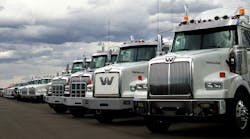A long, leisurely drive among the rolling hills of Northern Virginia might seem counterproductive in these fuel conscious times, but just such an adventure gave me interesting insight into the challenges facing automotive and light-truck engineers today.
While piloting several models of Buick's new 2006 Lucerne up and down narrow country lanes and broader byways, I picked Ed Zellner's brain pretty thoroughly. Zellner, a vehicle chief engineer, has been designing engines, brake systems, suspensions, etc. at General Motors for nearly 40 years. Today, he's working more closely with his light-truck engineering counterparts than ever before.
“We face the same core issues,” he explained. “How do we get everything the customer expects — from good ride and handling, interior space and comfort, safety, functionality, long-term reliability, and fuel economy — into one vehicle at a low cost for us to manufacture? So we're sharing more engineering information between the car and truck divisions.”
Before any of those issues can be addressed, engineers must first face the weight and cost hurdles, he pointed out. “You add even a tenth of a kilogram to one component — maybe to boost structural integrity, maybe to add more electronic capability — and it can add up quickly,” Zellner noted. “Cars and light trucks today have between 2,000 and 3,000 parts. Add a few kilograms and suddenly the vehicle goes up a test class weight, changing its whole performance dynamic.”
Zellner's colleague Bill Peterson, vehicle performance manager for the Lucerne, put it this way: “We work in this box — a box that can only have a certain size and certain weight. So despite anything we want to do to improve or change the capability of that vehicle, it has to stay in that box.”
Using lighter and stronger materials such as carbon fiber or aluminum can solve the weight equation, Zellner added, but that's when the cost issue rears up.
“Carbon fiber, for example, is made through a chemical process. Not only is it more expensive, but it takes much more time to create the shapes you need,” he explains. “We can stamp out 400 roof steel structures in an hour with almost the same consistency every time. You can't do that with carbon fiber material.”
Although more malleable, aluminum is far pricier than steel, so vehicle manufacturers use it only selectively to reduce weight. “The Lucerne, for example, has an aluminum hood. That helps us save weight, but doesn't push up manufacturing costs, nor the final sticker price,” Zellner said.
That's why making advances in vehicle capability, he said, requires almost laser-like focus on extremely small details. Just slight alterations here and there can produce major results.
Take forward crash protection, said Zellner. To give the Lucerne more frontal crash protection without adding more weight, his team moved the two front “prongs” of the engine cradle forward just a few inches, enabling the cradle to help absorb frontal impact energy before the bumpers and vehicle structure come into play.
Dual-function materials rule now, said Zellner, pointing to injected foam material that hardens into a light, firm shape filling the body panels to not only insulate the interior against noise, but also offer more energy absorption for crash protection.
These are all things being shared with the engineers working on GM's new GMT900 light truck platform, Zellner added. “We're all working on ways to build more safety, longevity, and capability into our cars and trucks, without adding to the price the customer has to pay,” he explained. “That's the focus of our engineering efforts for the future.”


